Affiliate links on Android Authority may earn us a commission. Learn more.
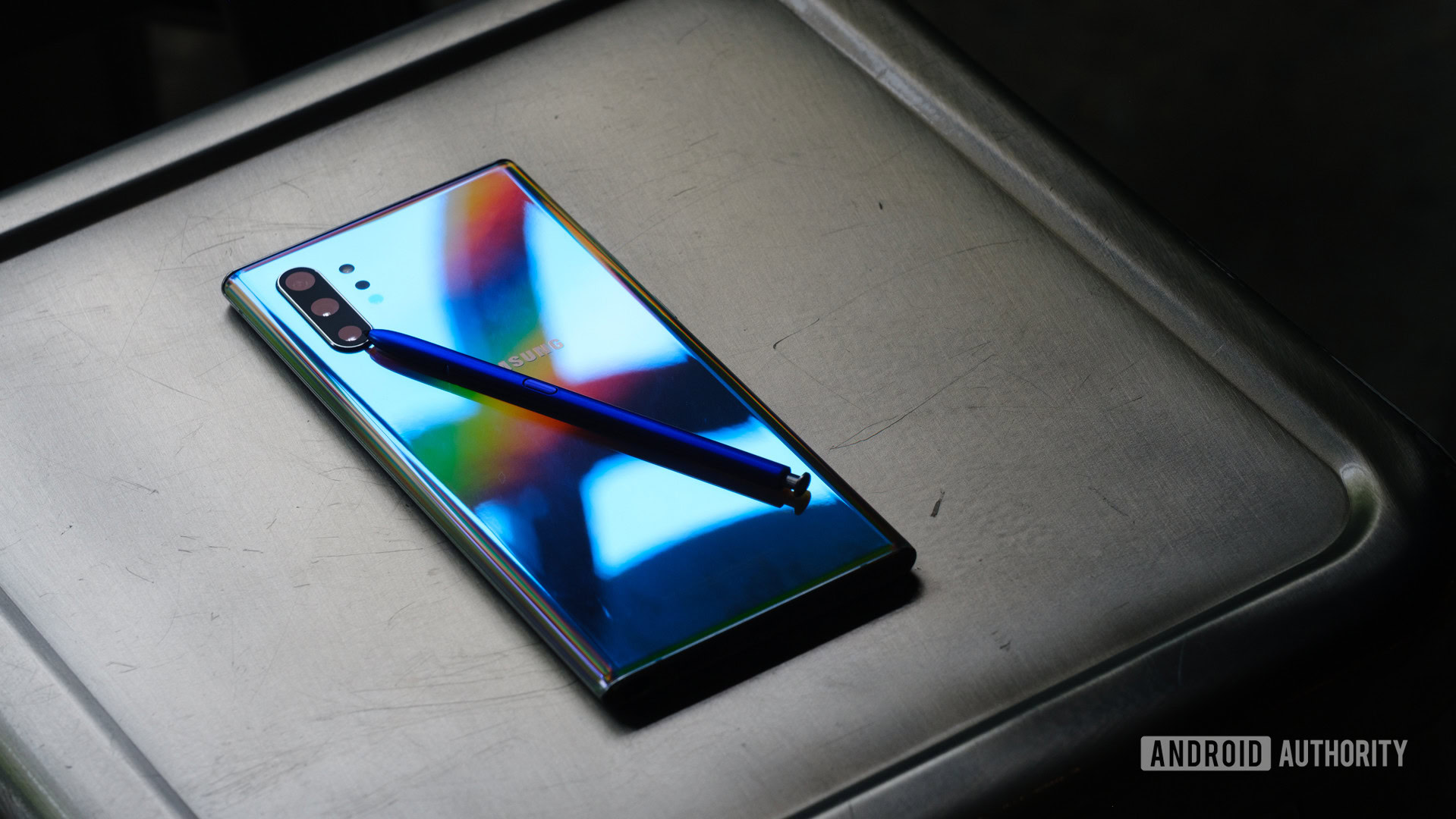

Samsung Galaxy Note 10 Plus review: Not the Note you know
Published onAugust 1, 2021

Samsung Galaxy Note 10 Plus
What we like
What we don't like
Our scores

Samsung Galaxy Note 10 Plus
The Samsung Galaxy Note has always been known as the do-everything device. Since the first Galaxy Note back in 2011, Samsung has used the series to rethink what our smartphones should be able to do, not to mention the sheer size of what we can do these things on.
The Samsung Galaxy Note 10 doesn’t reinvent anything we’ve seen on previous Notes. Rather, like the Galaxy Note 9, it iterates in a lot of departments to feel more modern, for better or worse.
Long-term review: Samsung Galaxy Note 10 Plus one year later: Is it still worth buying?
The Note 10 Plus is bigger, faster, and thinner than ever before, but I get the feeling Samsung is shifting its market demographic from the power user who wants it all, to all the users, who also happen to want power.
This is Android Authority’s Samsung Galaxy Note 10 Plus review.
Samsung Galaxy Note 10 Plus review: The big picture
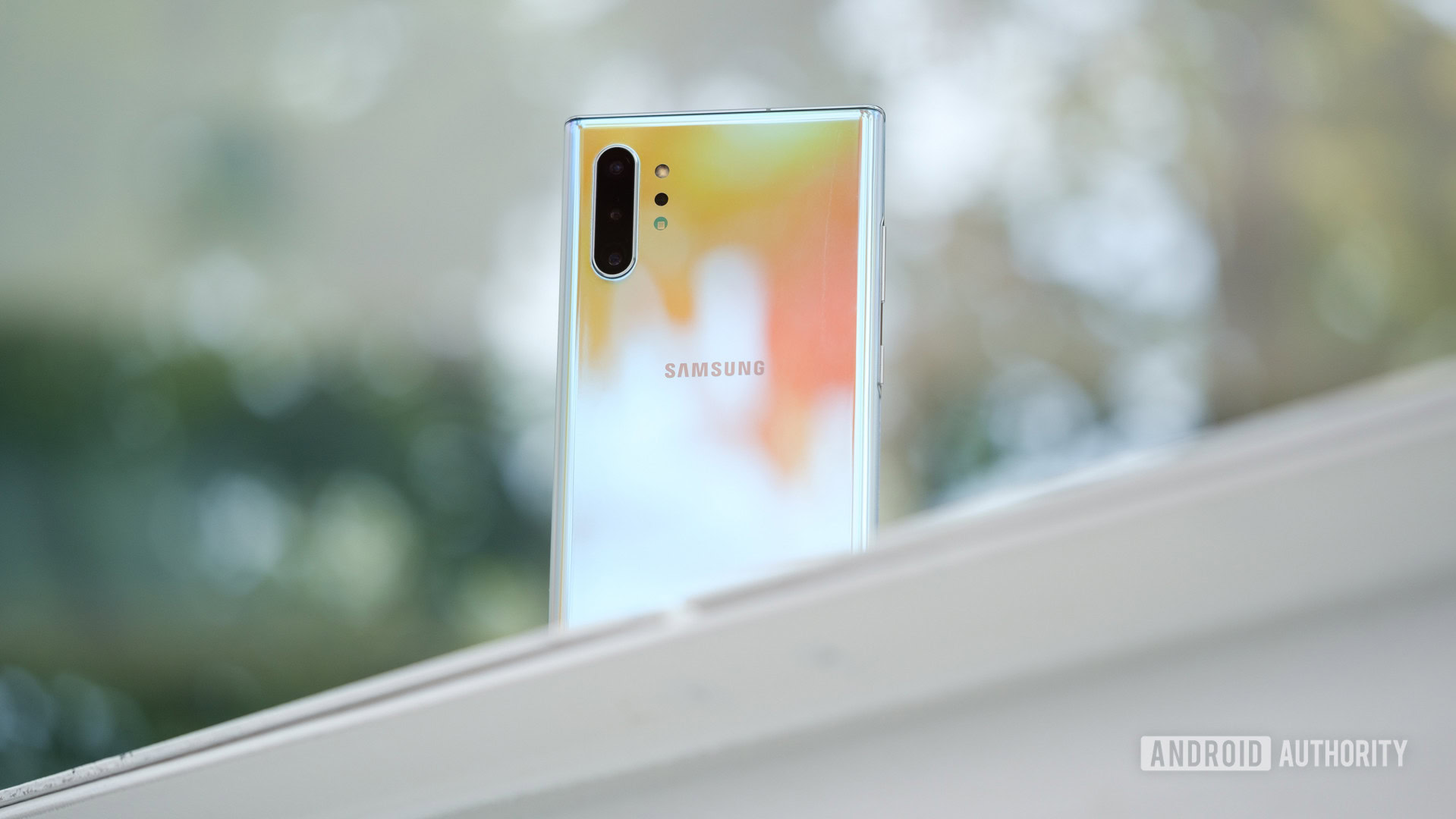
The Galaxy Note 10 Plus is Samsung’s biggest, boldest Galaxy Note yet. It has a slimmer design, more screen than ever before, and an S Pen that has learned some new tricks. Almost all of its new features are in the name of refinement, but that refinement is dictated by design and mass-market appeal, not necessarily by functionality.
This isn’t to say the Galaxy Note 10 Plus isn’t a powerful device, or that putting design first is inherently bad. With a Snapdragon 855 processor, 12GB of RAM, and a baseline of 256GB of UFS 3.0 storage, this thing flies. The screen is bigger and brighter, the battery is bigger and charges faster. The Note 10 Plus is, undoubtedly, the most refined Note yet.
The Note 10 Plus is, undoubtedly, the most refined Note yet.
But when you look at everything as a whole, it’s clear what guided the direction of the Note this generation. With the Note 9, Samsung slung huge banner ads reading “4,000mAh” and “1TB.” These were the major selling points for the phone. With the 10 series, it’s not about that at all. The Note 10 Plus is still better than ever, because if it wasn’t Samsung’s “best Note ever,” it wouldn’t sell any units. But if you look at the key marketing points of the Note 10 series, it is all about design.
Good design appeals to everyone. Everyone is not a power user.
Further reading: Check out our impressions on the standard Galaxy Note 10 in our review
What’s in the box
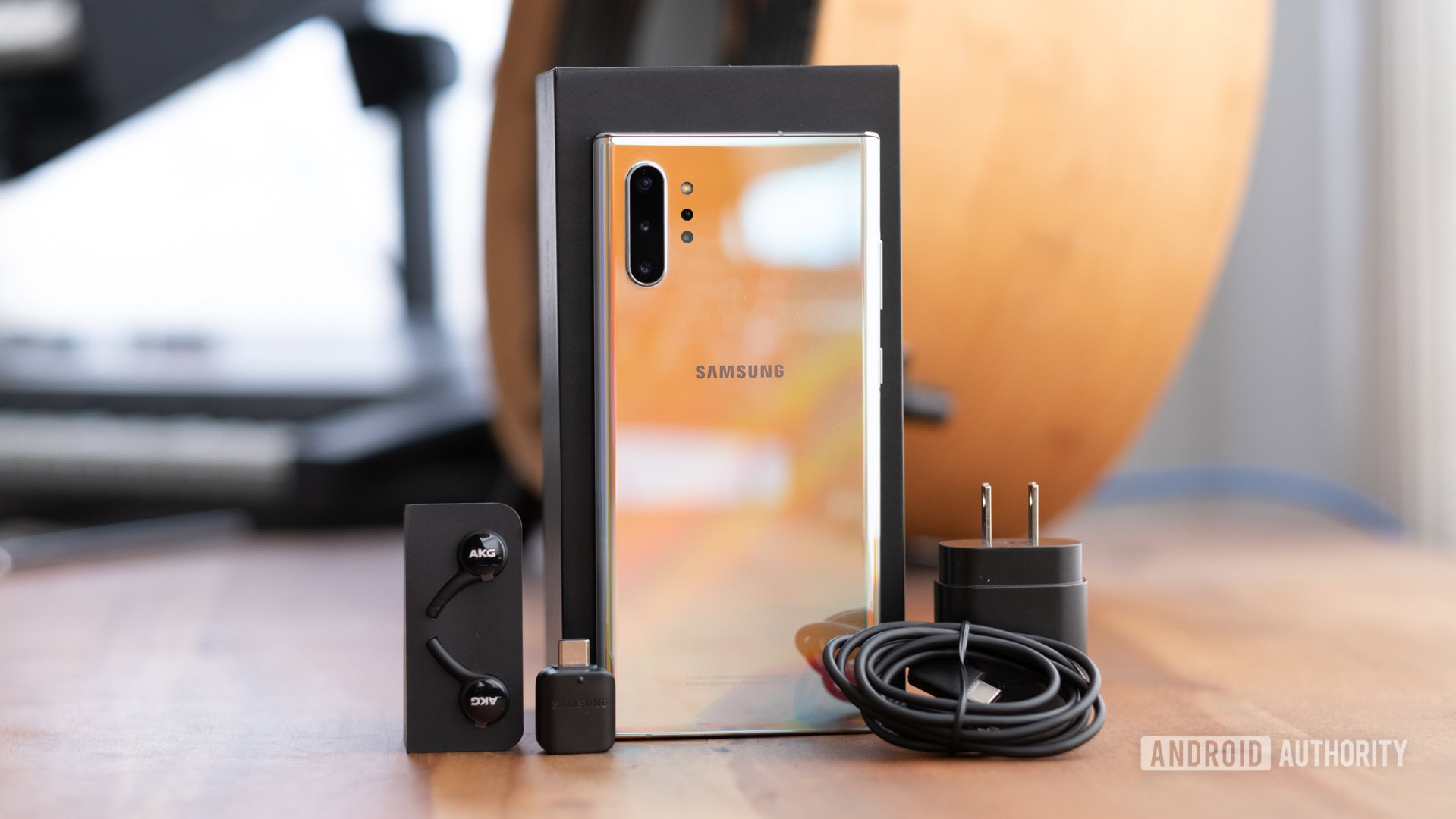
- 25W USB-PD charging brick
- Black USB-C to USB-C cable
- Black AKG USB-C headphones
- USB-A to USB-C adapter
The Samsung Galaxy Note 10 Plus comes with a 25W charging brick, but this brick supports USB Power Delivery (USB-PD). This means the charger and the phone can communicate to determine how many volts and amps are used when charging. You can learn more about USB-PD here.
25W charging provides a good balance between charging speed and long term battery health. Optionally, you can buy a 45W charger that will fill up the battery even faster. It costs $50 on Samsung.com.
The Galaxy Note 10 Plus also comes with a black USB-C to USB-C cable, a first for a Samsung phone, as well as some black USB-C AKG headphones.
Samsung also includes a USB-A (female) to USB-C (male) adapter in the box. This used to be included to allow you to transfer data from your old Android device if you didn’t have a USB-C to USB-C cable, but now that Samsung includes one in the box, this seems fairly pointless.
In-depth: Samsung Galaxy Note 10 Plus fast charging explained
Design
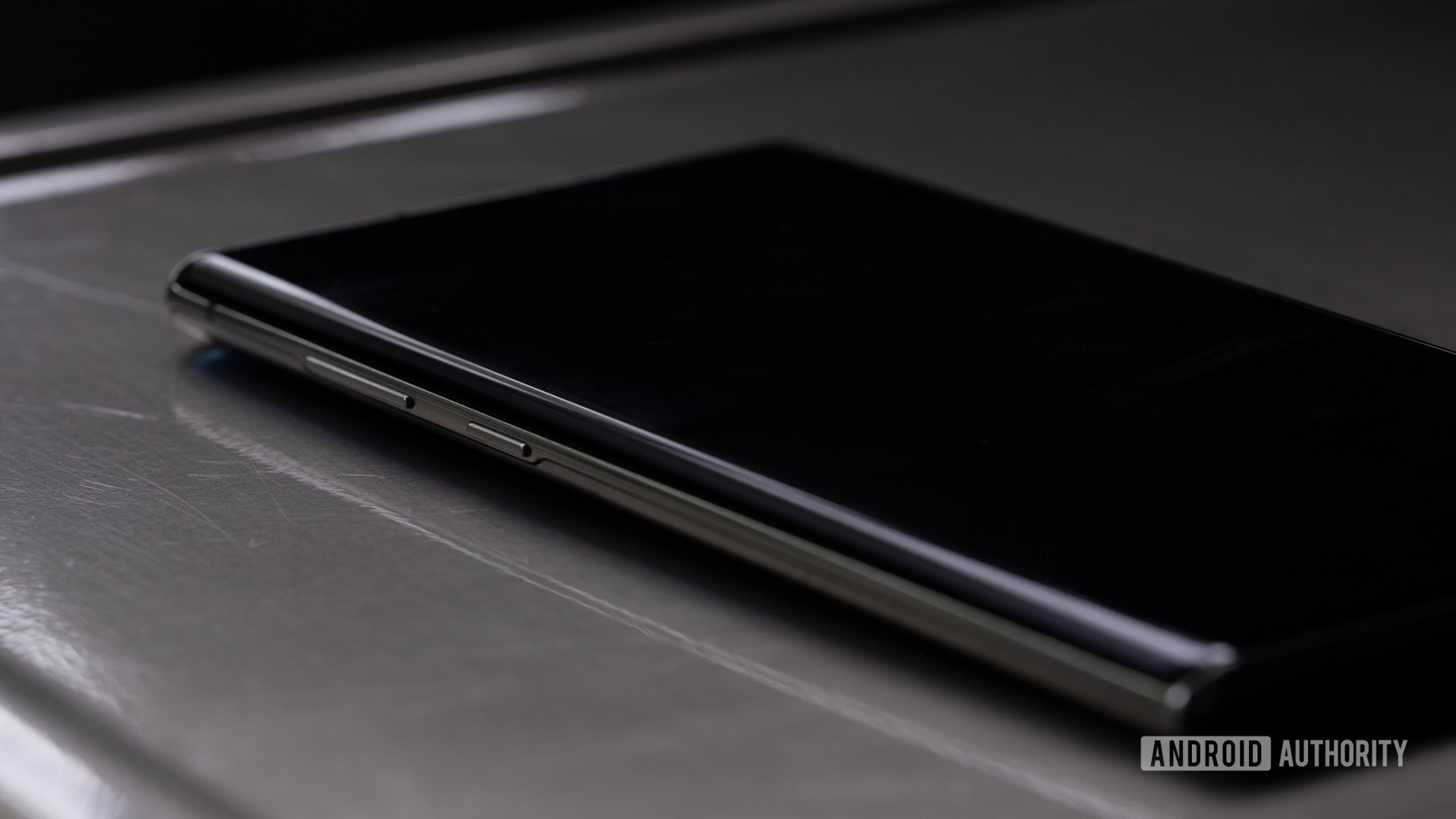
- 162.3 x 77.2 x 7.9mm
- 196g
- Infinity-O punch-hole camera
- Curved display edges
- S Pen
- Stereo speakers
With the launch of the Samsung Galaxy S10 series, Samsung refreshed its design to feel brand new. With the launch of Note 10, Samsung is following this evolution, to an even more extreme degree.
The Note 10 Plus’s bezels are smaller than nearly any phone Samsung has ever produced. Instead of putting the camera cutout in the top right corner though, Samsung has moved the camera cutout to the top center. I like this design because it doesn’t feel like it gets in the way of your content. I was already happy with the Infinity-O display in the S10 series, but this cutout is even smaller. This does come at the expense of a smaller camera aperture compared to the Note 9 — another indication that Samsung was obsessive about making this device beautiful. Front-facing camera shots still look great though, so this is a fine trade-off for me.
The body of the Note 10 Plus is boxy, which is a tradition for Note devices. This year, the phone feels even boxier, but I’ve grown to like it. Note 9 felt like it wanted to be boxy but still added a curve to the corners. While this phone is not as squared off as the Razer Phone 2 or an old Sony Xperia, the relatively squared-off design with curved sides feels nice in the hand.
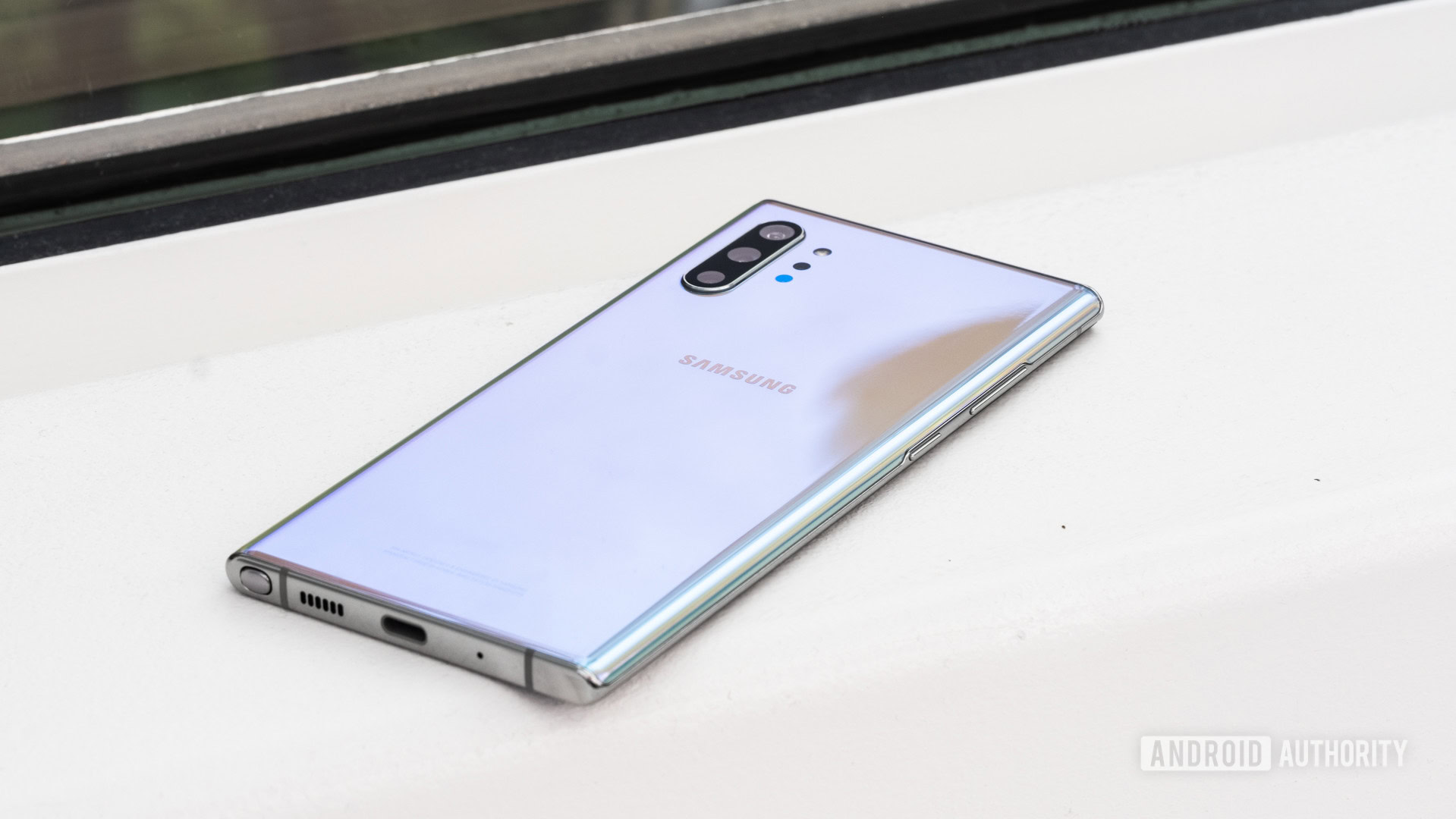
The Note 10 Plus is considerably thinner than the Note 9, at just 7.9mm versus 8.8mm on the Note 9. Interestingly though, even with a huge 6.8-inch display, it maintains about the same footprint as the Note 9, mostly due to the reduced bezels. I would have preferred the device remained the same thickness and include an even larger battery, but like with other refinements this phone has made, the design was clearly a priority.
The back of the phone looks elegant, with a vertical triple-camera system down the left side. Other than two flash LEDs and a depth camera, the back of the phone is totally clean. On my Aura Glow model, the phone refracts light to create some amazing colors. The Galaxy S10 Prism White shifted from white to blue to red, but the Aura Glow Note 10 Plus can turn just about any color of the rainbow. It’s one of the most visually appealing phones I’ve ever seen and has been one of Samsung’s key marketing points for the device, again, for better or worse.

I appreciate beautiful technology, so if Samsung was going to make the glass a solid sheet of Gorilla Glass 6, I’m glad it put in the extra effort to make it shine.
The sides of the phone have a much thinner aluminum frame than the Note 9 and even the S10. The glass wraps around the edges more, almost feeling like a solid extruded piece. It looks nicer than a thicker metal frame, but from the moment I saw this phone I was worried about it breaking. Lo and behold, two days later, that became the case. My unit managed to slide off a table onto concrete from about four feet up and hit the bottom left corner, causing hairline fractures. Unfortunately, this is a necessary trade-off. Samsung likely used this glass-heavy design to maintain consistency with the 5G model, which needs more glass on the sides for its mmWave antennas to work. We saw nearly the same design on the Galaxy S10 5G.
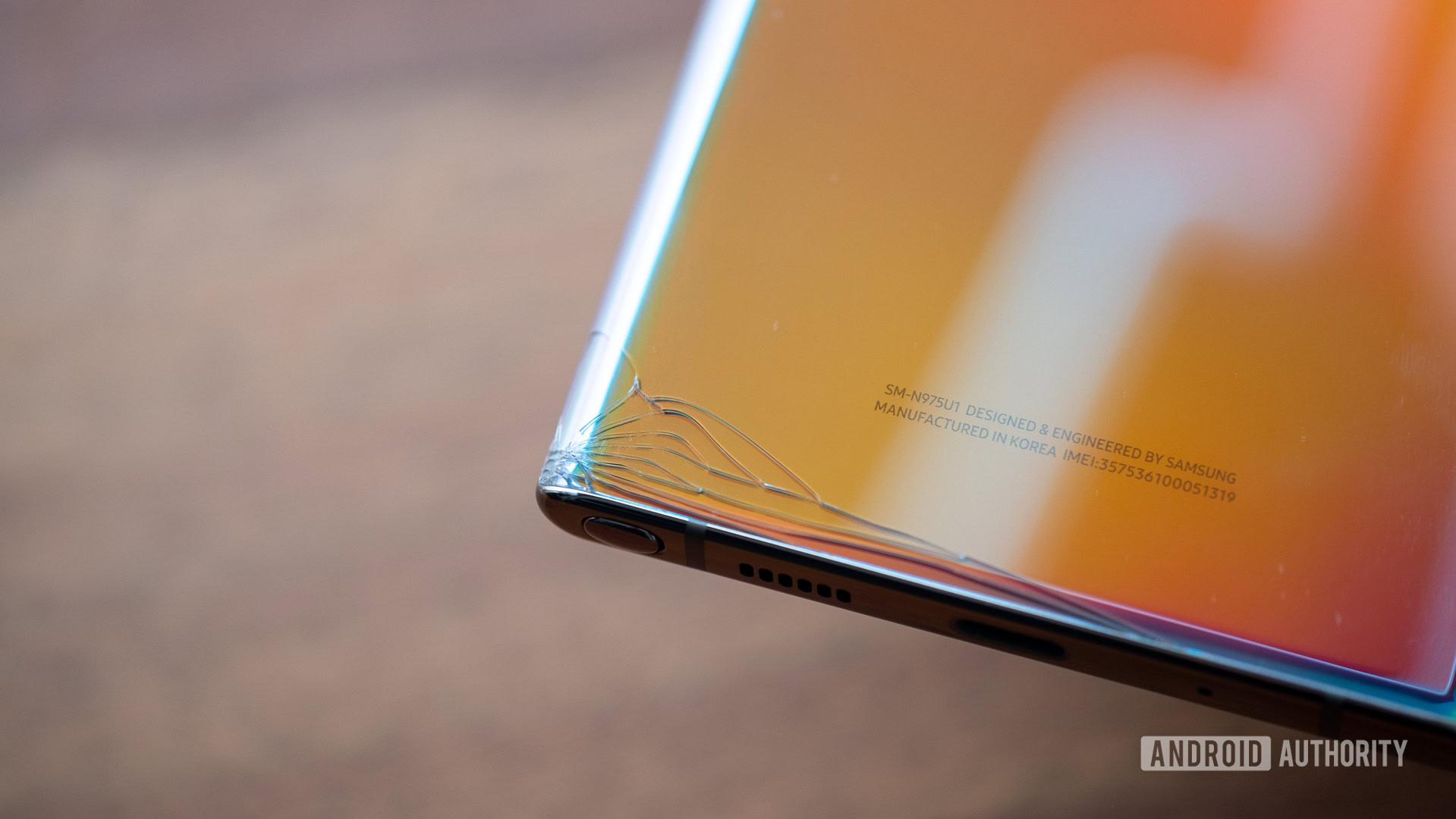
This introduces an interesting conversation as to whether or not you’re willing to trade fragility for beauty. The Galaxy Note 10 is one of the prettiest phones I’ve used. But extra glass also means it’s slightly more fragile because more glass introduces more risk. You’ll need to decide if you’d rather use a case and save it from damage, or keep it naked and take in how pretty it is.
Related: Best Samsung Galaxy Note 10 Plus cases | Best Galaxy Note 10 Plus screen protectors
On the bottom of the phone, you’ll find a slot for the iconic S Pen, a speaker grille, and a microphone, but no headphone jack. I’ll continue to hammer this in: Headphone jacks should not be removed until we have a ubiquitous replacement. Currently, the state of USB-C headphones is abysmal, to put it lightly, and Bluetooth is still clunky. The fact that the headphone jack has become a mid-range feature is disgusting, and no one should be punished for not having the funds or preferring to not purchase expensive Bluetooth headphones.
The right side of the device is clear of any buttons or ports. Samsung instead opted to move the power button to the left side, right under the volume rockers. This is where the Bixby button used to be, but now it’s been completely removed. I’m honestly fine with this change. At first, I thought it would be hard to turn the device on and off, but I usually use the in-display fingerprint sensor anyway, and I can easily turn the device on and off with my index finger versus my thumb. Like most things, this took about a day to get used to, but then it felt completely normal.
On the top, you’ll find a SIM tray with microSD expansion, a speaker, and a microphone. (The standard model Galaxy Note 10 does not have microSD expansion.)
Display
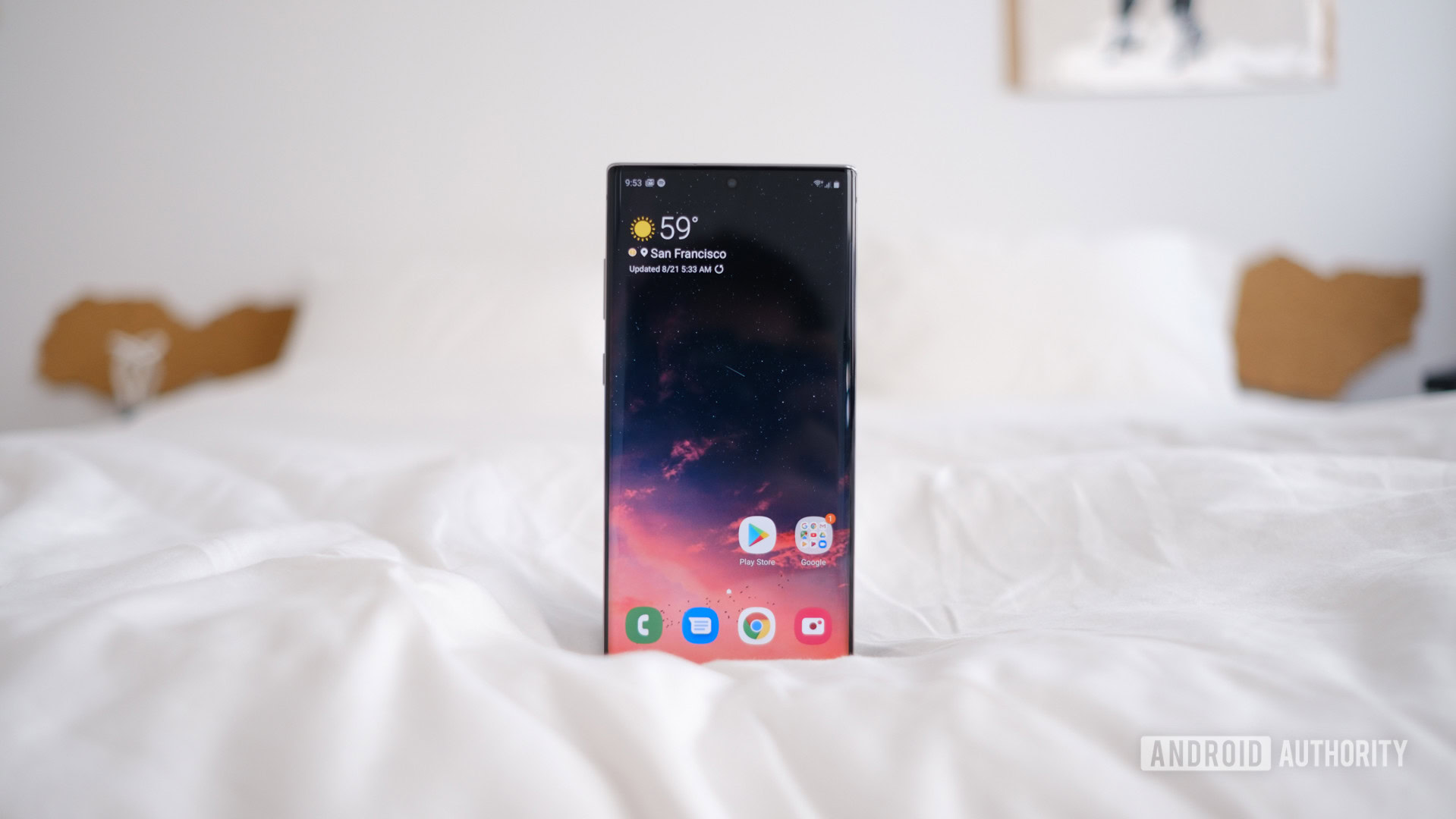
- 6.8-inches
- 3,040 x 1,440 Quad HD+ resolution
- 19:9 aspect ratio
- HDR10 / HDR+ certified
- 498ppi
- In-display ultrasonic fingerprint reader
Like the Note 9, the Galaxy Note 10 Plus continues Samsung’s heritage of having one of the best displays on the market. This isn’t surprising considering Samsung is the biggest AMOLED manufacturer on the planet.
Samsung has won 13 DisplayMate awards for the display on the Note 10 Plus, and I would say the awards are justified. The Note 10 Plus’ Dynamic AMOLED display looks brilliant. It’s bright and punchy but not overly saturated, and you have the option to use a “vivid” color profile if you’d prefer a bit more punch. HDR 10 and HDR+ certification also gives you much more information in the shadows and highlights of HDR content, so if you’re watching that extremely dark episode of Game of Thrones, you should be able to see a lot better.
Before its announcement, rumors circulated that the Galaxy Note 10 would have a 90Hz display, but that’s not the case. We’ve seen devices from OnePlus and Asus with high refresh rate displays this year, but Samsung stuck to 60Hz in the Note 10 series. A higher refresh rate would have been nice, but since most apps don’t support higher rates quite yet, it’s not a deal-breaker for me personally. 90Hz is not yet something the mass market is asking for, and with the Note 10 Plus, features seem to have been guided by wider consumer needs, not power users.
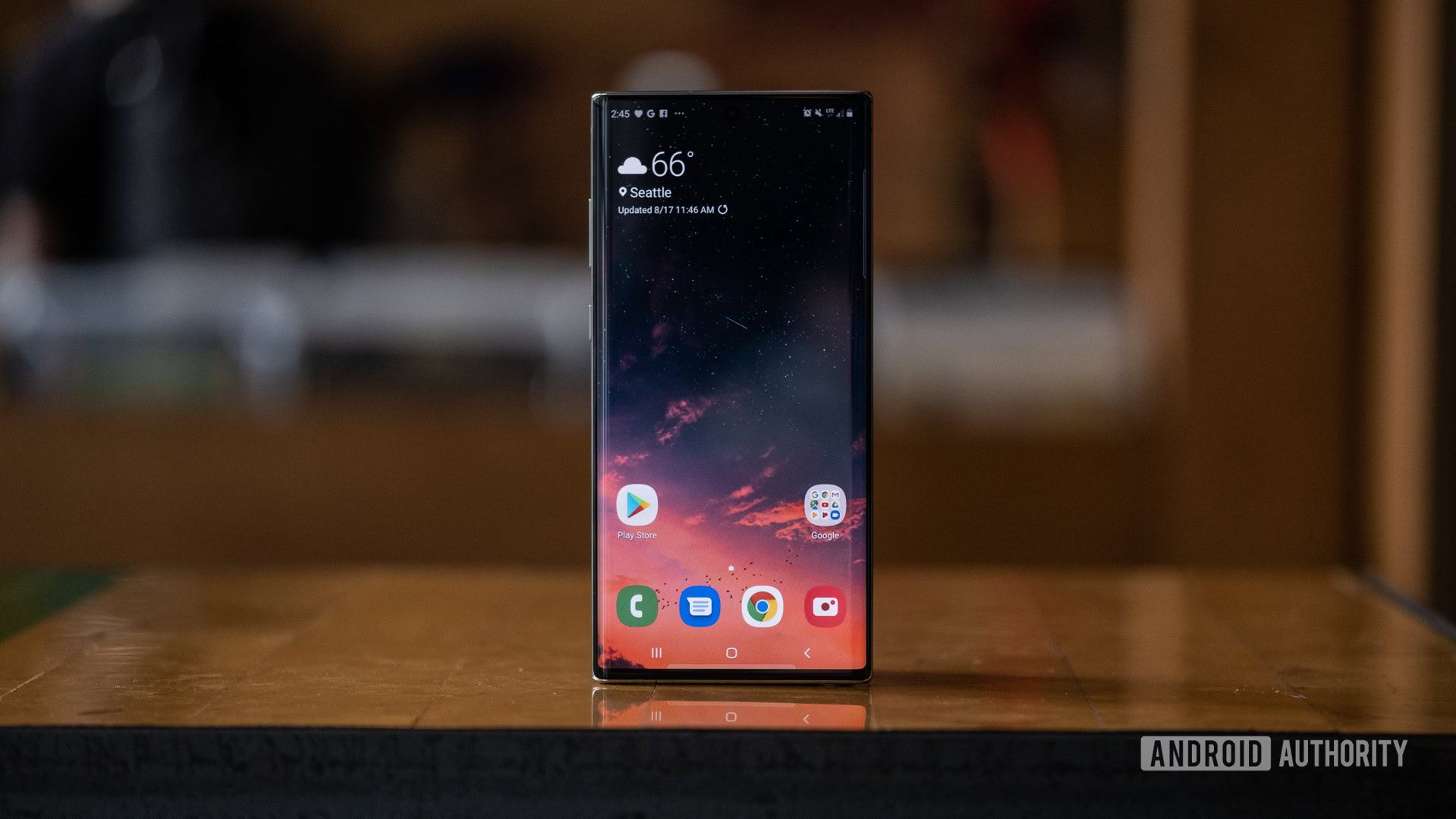
As for the size, 6.8-inches is pretty massive, but surprisingly the phone doesn’t feel unwieldy. I don’t know if I’m just slowly getting more accustomed to larger devices, but the Note 10 Plus feels pleasant to use. This is probably due to the 19:9 aspect ratio. Because the Note 10 Plus is effectively the same footprint as the Note 9 with more screen and less bezel, it feels familiar.
6.8-inches is pretty massive, but surprisingly the phone doesn’t feel unwieldy.
I am using the default One UI launcher, which makes elements on the screen larger and easier to reach versus other launchers, so this may be part of why the screen feels so usable. I tried the Galaxy S10 Plus again after using the Note for a few days and it felt tiny by comparison. Funny how we adapt to these things.
Samsung has also put the same ultrasonic in-display fingerprint sensor that we saw in the Galaxy S10 series in this device. It’s not any newer than the one we saw previously, but it seems more accurate. Where the S10 seemingly misread my fingerprint more than it read it correctly, the Note 10 Plus has had a much higher success rate. This may be attributed to the fact that Samsung moved the sensor higher on the display than it was on the S10 Plus, making it easier to press naturally. While it isn’t perfect, and I had much more success with the OnePlus 7 Pro‘s giant optical sensor, readings have improved for me.
Performance
- Qualcomm Snapdragon 855
- Octa-core
- Adreno 640 GPU
- 8GB or 12GB of RAM
- 256GB or 512GB of UFS 3.0 storage
- Expandable storage
Based on the specs, the Samsung Galaxy Note 10 Plus should fly, and it does — I didn’t notice any hiccups or stuttering while using the phone, in line with other Snapdragon 855 devices, especially those with 12GB of RAM.
In benchmarks, the Galaxy Note 10 Plus scores well. It achieved a score of 369,029 in AnTuTu, compared to the 360,414 on the Galaxy S10 Plus. In 3DMark, it achieved a score of 5,692 compared to the S10 Plus’ score of 5,239. In Geekbench it nabbed 3,434 and 10,854 for the single-core and multi-core tests, respectively versus the 3513 and 11148 scores on the Galaxy S10 Plus. In Gary’s Speed Test G, the Samsung Galaxy Note 10 Plus finished the course in 1:30:381, besting the Galaxy S10 by about two seconds.
Battery
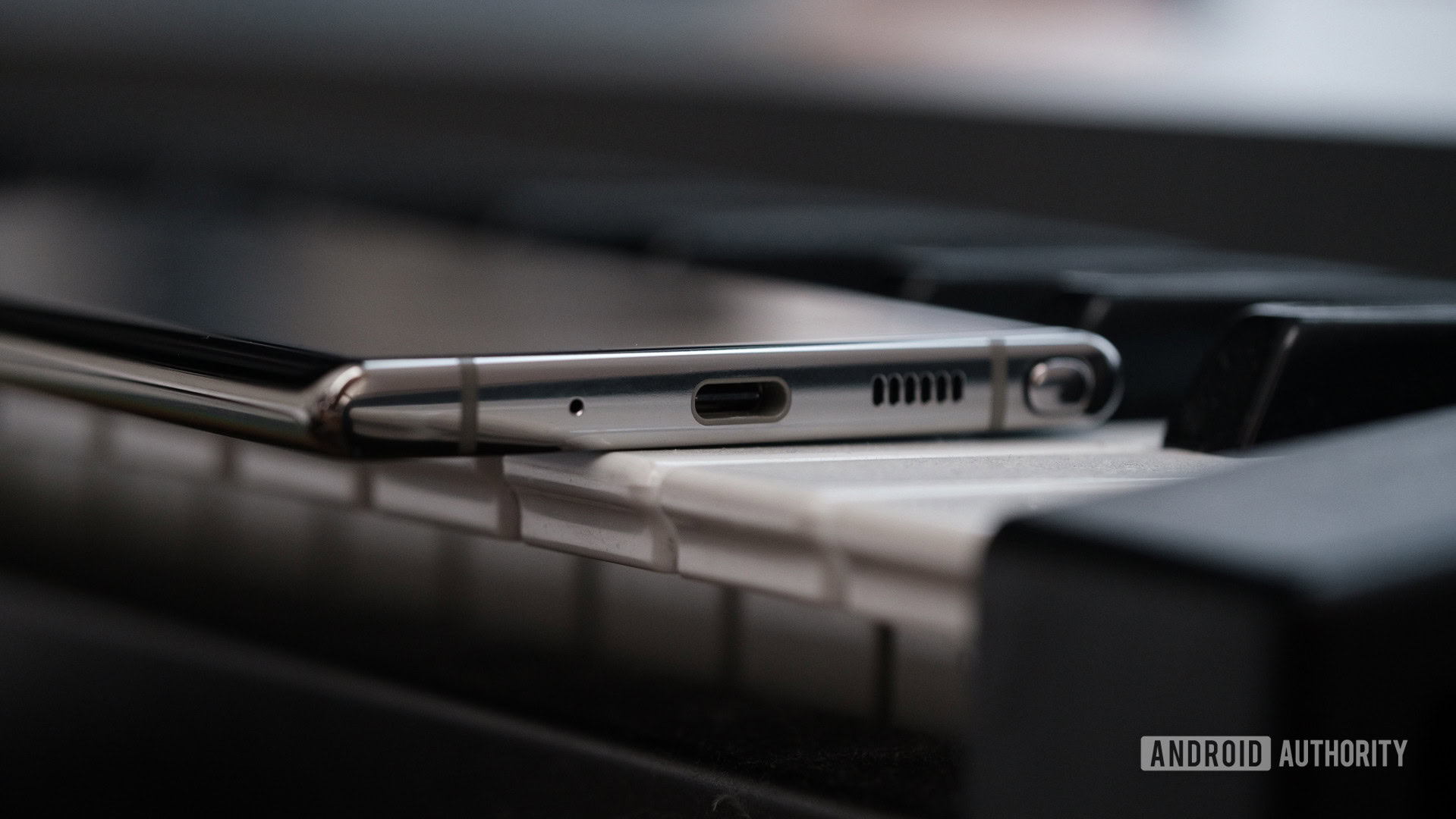
- 4,300mAh
- Up to 45W charging (25W included in box)
- Wireless charging (15W)
- Reverse wireless charging
The Samsung Galaxy Note 10 Plus uses a 4,300mAh battery, up 300mAh from the Galaxy Note 9. This isn’t a huge bump considering the screen went from 6.4-inches to 6.8-inches, and while it can certainly last you a full day on a charge, this isn’t going to be a two-day device, at least for a heavy user.
One day, I got 5 hours and 2 minutes of screen-on time. The next, I got 7 hours and 33 minutes. On average, if I unplugged my phone at around 9 am, it would be near dead by around midnight.
This isn’t to say the Note 10 Plus has bad battery life — it’s just fine. I was hoping for a bigger battery though, since the screen is noticeably bigger than both the last Note and the Galaxy S10 Plus. It’s clear Samsung has been trying to play it safe ever since the Galaxy Note 7 incident.
Average battery life can be somewhat forgiven if the phone charges quickly, and Samsung included a 25W USB-PD charger in the box. This isn’t the fastest charger we’ve seen in a smartphone, but 25W is respectable. Real-world testing got the device from 0 to 100 percent in about 75 minutes, which can come in pretty handy when you need a quick jump.
Add to this the fact that this is a PD charger, which can intelligently step-up the voltage to more safely deliver power, as well as talk directly with a device to see how many volt and amps it can handle, and you’ve got a thumbs up from me. Most fast-chargers use proprietary standards, and I’m glad to see Samsung adopting something open. Samsung also sells a 45W charger, and I’m eager to try that out when I can get my hands on it.
Camera
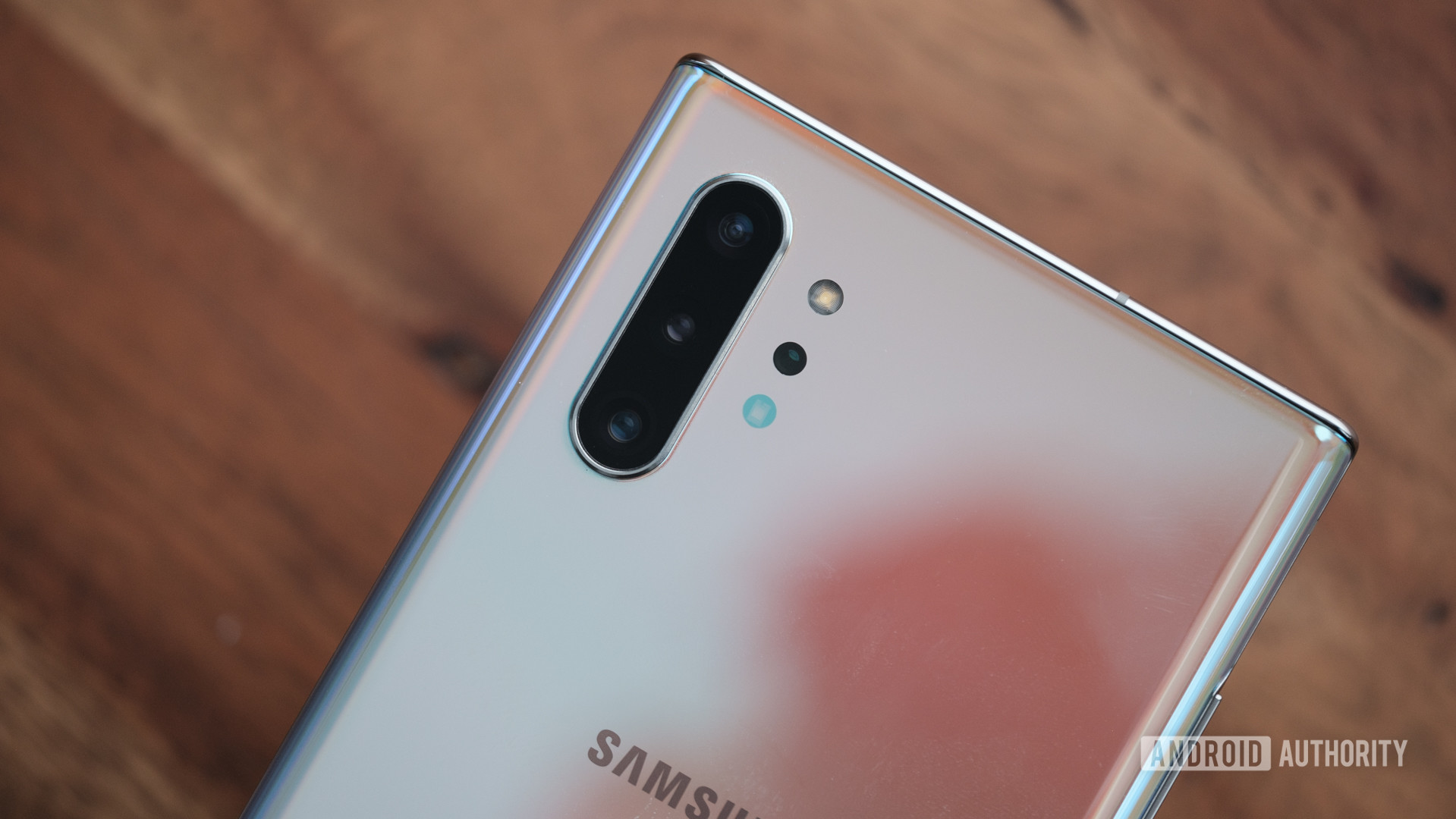
- Standard: 12MP, f/1.5-f/2.4, OIS, 77-degree FoV
- Wide-angle: 16MP, f/2.2, 123-degree FoV
- 3x Telephoto: 12MP, f/2.1, OIS, 45-degree FoV
- Depth Vision VGA camera
- Selfie: 10MP, f/2.2, 80-degree FoV
The rear set of cameras on the Samsung Galaxy Note 10 Plus is effectively unchanged from the Galaxy S10 Plus. You’ve still got the same wide, standard, and telephoto lens, which give you quite a bit of versatility when shooting photos. The placement of the camera array is also better in my opinion because you no longer get your index finger in wide shots.
The overall quality of the Note 10 Plus camera is very similar to the Galaxy S10 Plus, but I feel Samsung has improved its processing a bit. Color is very good and the HDR is far less dramatic. The Galaxy S10 Plus would raise the shadows and blacks of every shot extremely aggressively, and the Note 10 Plus does a better job of having more contrast in shots.
The wide camera is amazingly versatile. It’s wider than nearly any other smartphone camera out there, but with that comes some aggressive distortion. This can be fixed in post-production if you want to, but the camera is still very useful for getting more in the frame and making things feel large.
The standard camera is the sharpest and has good color. It also has the widest potential aperture of the three cameras.
The telephoto camera also seems improved, probably from a software level. It’s quite sharp, which is rare for telephoto cameras on smartphones. It has just as good color as the other two cameras as well, and it’s nice seeing relatively equal profiles across all three lenses.
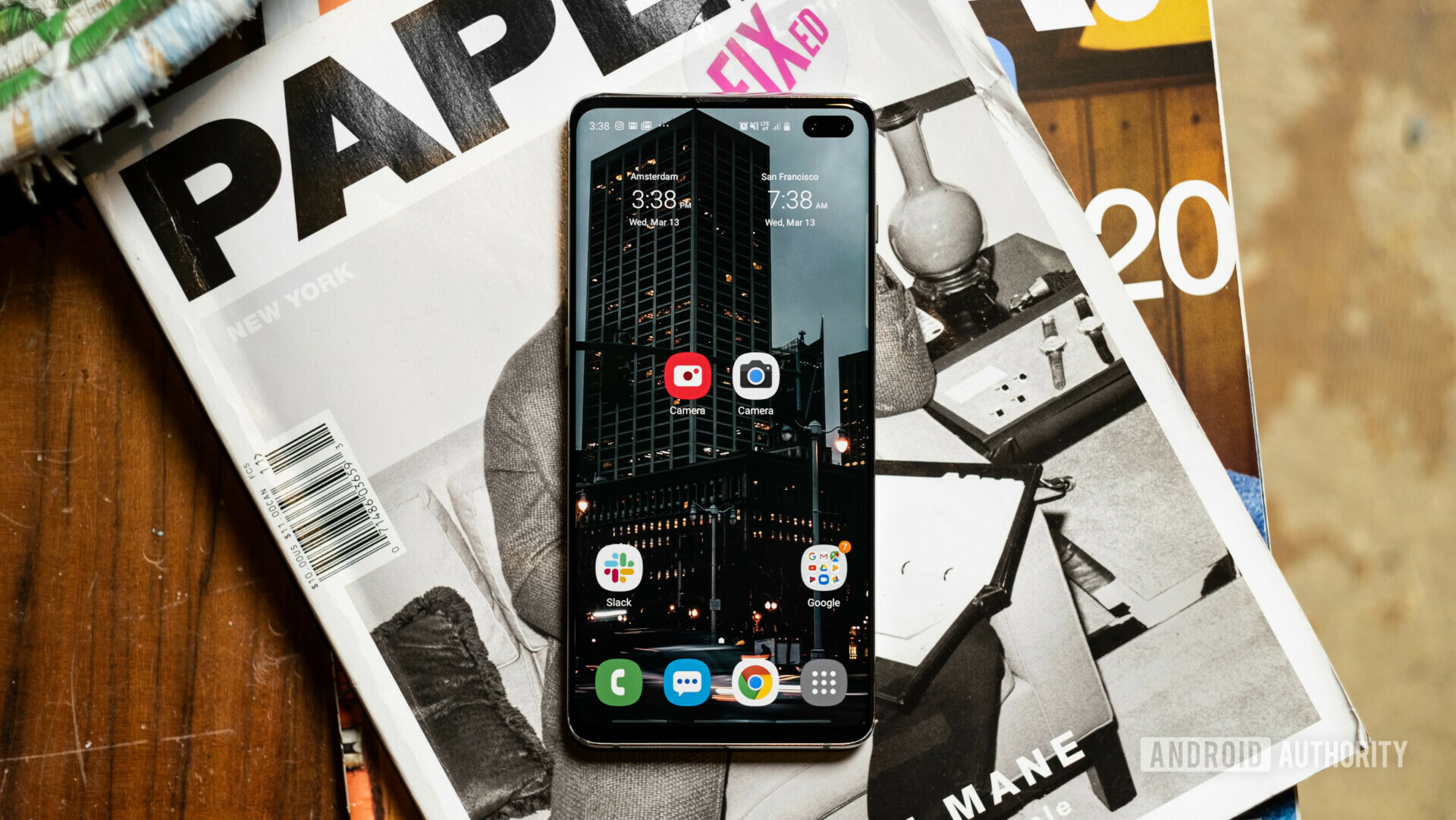
The Galaxy Note 10 Plus also comes with a “Depth Vision” camera. This is primarily used for making 3D models of objects. Samsung lets you manipulate these models in post, and even export them to software like Blender 3D. There is no Depth Vision camera on the smaller Galaxy Note 10.

Unfortunately, like other Samsung cameras, the Note 10 Plus struggles in low light. The Note 10 will leave the aperture open for a while to get enough light, which causes quite a bit of smearing if the subject is moving at all. The phone will also overdo contrast in low-light scenarios, blowing out highlights and crushing blacks and shadows.
The front-facing camera on the Note 10 is very good. Images are sharp and have good color. Dynamic range is good and I think it looks even better than the rear cameras. This is surprising because Samsung had to make the aperture smaller on the Note 10 selfie camera than it was on the Galaxy Note 9. Still, I’m quite happy with the results.
There are some new camera modes in the Galaxy Note 10 series, such as “big circle,” “glitch”, and “color point.” Big circle emulates a very high aperture on the background and completely blurs the background with some nice bokeh. You can change the amount of blur with the slider. This works well, and I think it looks very natural.
Glitch adds a 3D glitch effect to your photos, while color point keeps the subject in color and makes everything else black and white. These effects can also be used in video mode, and they work well.
Live focus video on the #GalaxyNote10 works pretty well. Nice natural-ish bokeh. I dig the glitch. pic.twitter.com/HUCFcVbZBI— David ImeI (@DurvidImel) August 16, 2019
Speaking of video, the Galaxy Note 10 Plus has some of the best video stabilization of any phone I’ve used. It rivals the HUAWEI P30 Pro in video stabilization, which is to say, it’s very, very good. Unfortunately, video struggles in low-light just as much as photos do. Highlights are blown out and shadows are crushed.
Also read: HUAWEI P30 Pro camera review: Next-level optics, low-light king
Full-size camera samples can be viewed here.
Software
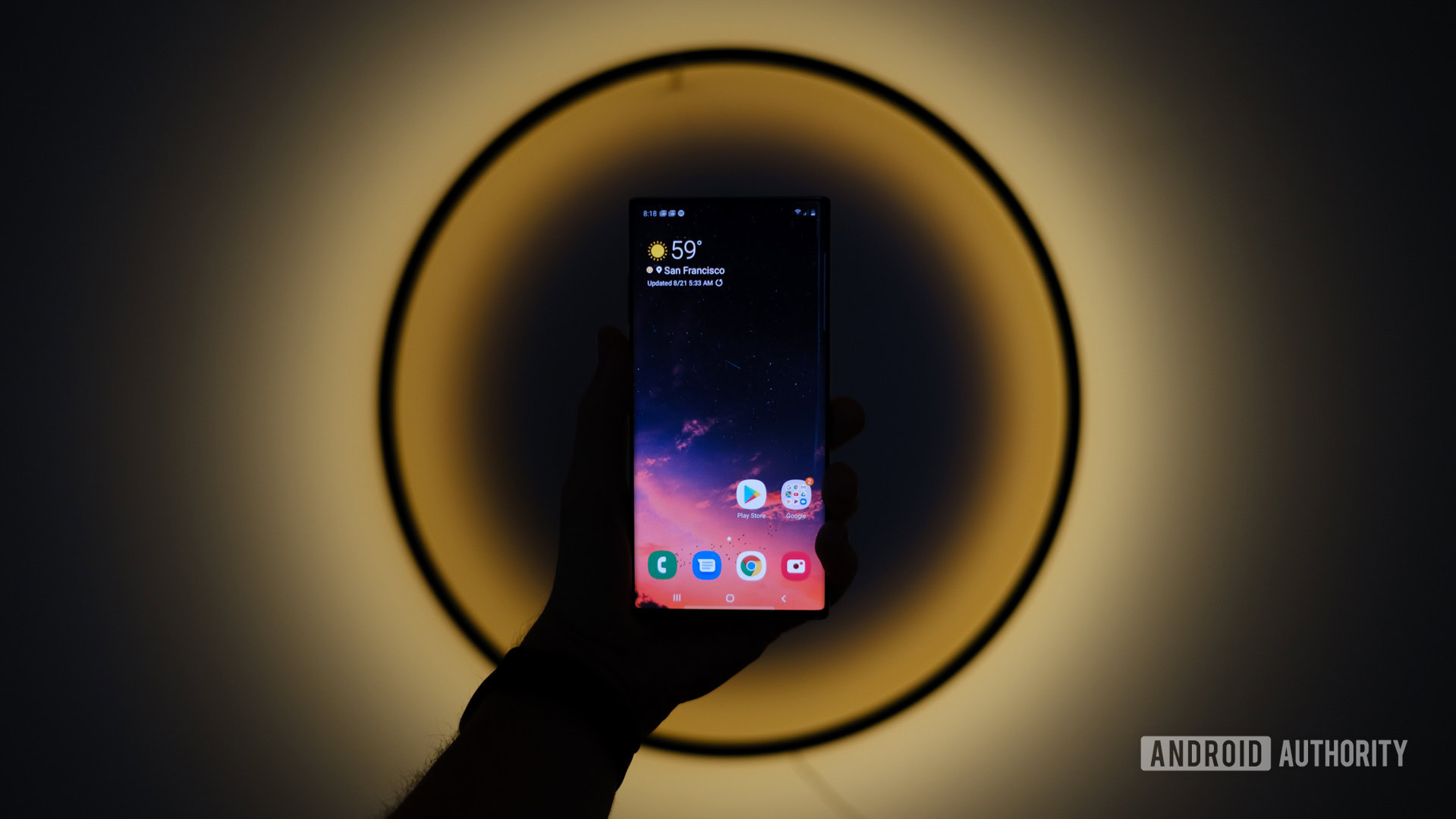
- One UI 2.0
- Android 10
Update: January, 2020: The Samsung Galaxy Note 10 Plus has now been updated to Android 10 with One UI 2.0. When originally reviewing the Note 10 Plus, it was running Android 9 Pie. There are multiple changes present in Android 10 and One UI 2.0 that you’ll want to take advantage of. For the original review of the software, see below.
You can manually check for the Samsung Galaxy Note 10 update on your own device by heading to Settings > Software update > Download and install.
Check out more information on system and security updates for the Galaxy Note 10 and Galaxy Note 10 Plus.
The Galaxy Note 10 Plus ships with One UI 1.5, which is based on Android 9 Pie. Like with the Galaxy S10 Plus, I’m a huge fan of this take on Android. Screen elements are large and easy to reach, and there are nice features like scrolling screenshots and a built-in screen recorder. If you’re a dark theme nerd, Samsung has included a dark theme in One UI as well.
I’m a huge fan of this take on Android
The one worry I have with this software is consistent updates. My Samsung Galaxy S10 Plus just received the July security patch, which is nearly a month overdue. Samsung may improve its update timeline, but it has not been the best at this historically.
The biggest software updates coming to the Note 10 Plus are an enhanced Dex experience alongside a new partnership with Microsoft called Link to Windows.
Also read: Samsung Galaxy Note 10 Dex desktop mode: A look at what’s new
Dex now works with any computer with any USB cable. This means you don’t need a dedicated monitor to use the platform. In a way, this defeats the point of Dex as something to replace your PC. That being said, it’s nice to be able to move files between your phone and computer more naturally, and you can even run apps on the virtual desktop.
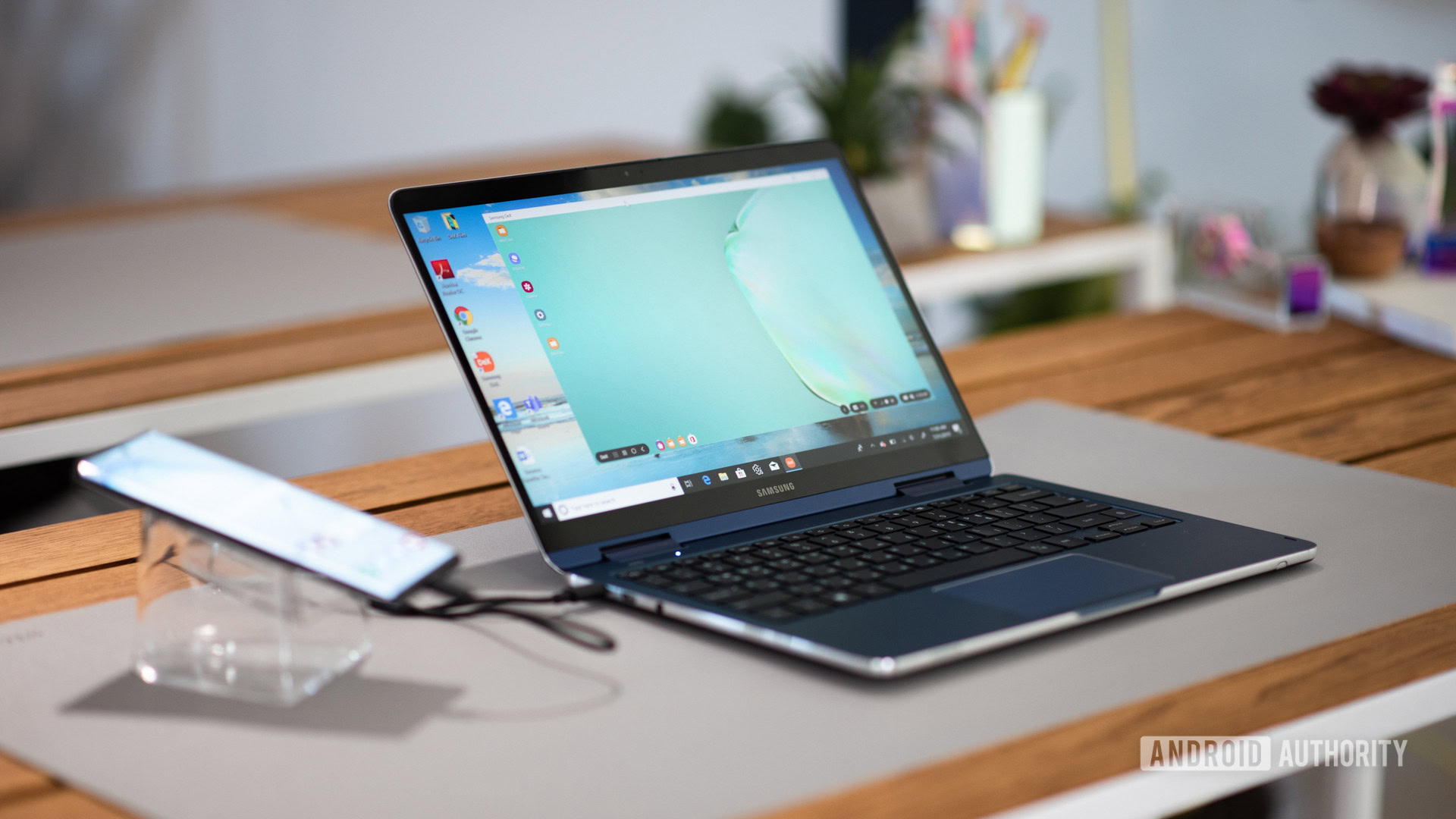
Link to Widows is a toggle you can turn on and off in your notification shade. The feature allows you to receive texts, photos, and other notifications on your Windows PC. Samsung is hoping this will be a suitable alternative to Apple’s ecosystem, which seamlessly links things like text messages between your Mac and iPhone. Using it to share photos is the most useful for me personally since I use Android Messages for web to handle text messages. As for notifications, I don’t really want more notifications on my PC.
Audio
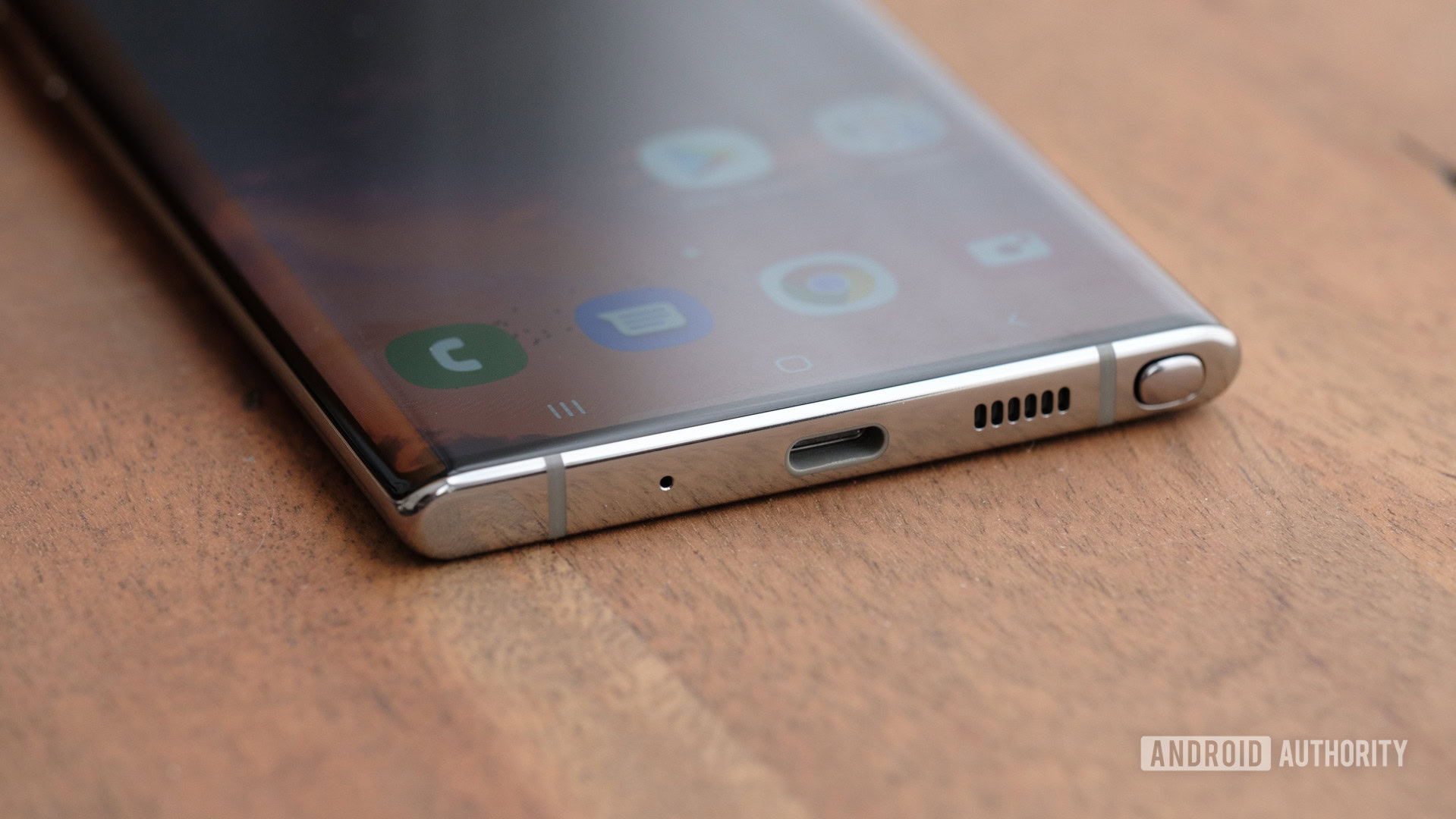
- No headphone jack
- Stereo speakers
The Samsung Galaxy Note 10 series is getting a lot of flack for dumping the headphone jack. In my opinion, this flack is justified. Samsung has been one of the few premium phone makers holding onto the analog jack, and dumping it in the phone that is supposed to “do everything” seems pretty abusive to its loyal fan base.
What are your thoughts on the Note 10 series dropping the headphone jack?— David ImeI (@DurvidImel) August 19, 2019
I asked my Twitter followers what their take on the jack removal was and got a fairly diverse response. Out of 13,356 voters, 55 percent said they didn’t care, and 45 percent said they were annoyed. Multiple people messaged me saying they were somewhere in-between — that it annoyed them but that they were still buying one. While I recognize I’d probably need more non-Android fanatics to answer this question to get an accurate assessment, this lets me infer that people are caring less and less about the headphone jack. I will still defend the headphone jack until the day we have a true replacement, but it seems the market is signaling that people aren’t nearly as hell-bent over it as they once were.
With that said, the Note 10 Plus has stereo speakers with Dolby Audio and also supports Bluetooth 5. The speakers sound very good and tested very well in our dedicated speaker test. If you want a phone that sounds good without a Bluetooth speaker, the Note 10 Plus is a great pick.
S Pen
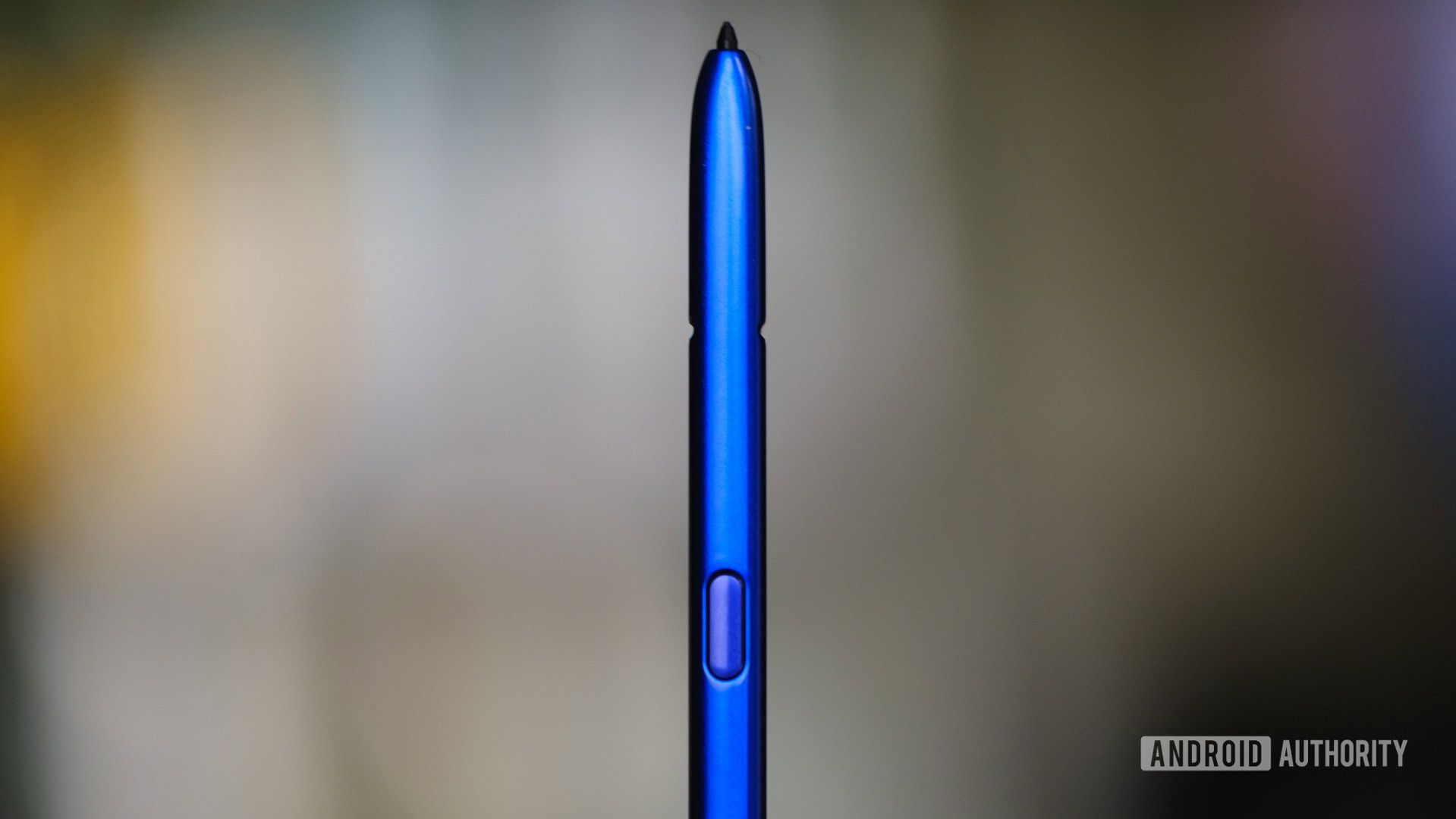
You can’t review a Galaxy Note device without talking about the S Pen. This year, Samsung has added a few new features. None of them feel particularly revolutionary, but you can’t fault Samsung for at least trying to make it better.
The S Pen in the Galaxy Note 10 series has a gyroscope in it, which allows it to perform Air Actions. This means you can perform gestures like swiping up and down and left and right to switch camera modes or make a swirling motion to zoom in with the camera. This can be decently useful for things like remote selfies, but I didn’t find any of the new gestures change how I use the phone.
Other new features include AR Doodle and improved digital text conversion. AR Doodle allows you to draw on people and things in virtual space. I like this feature, even if it’s relatively gimmicky. I’ll probably use it on objects much more often than people, even if it is fun to add bunny ears to your friends from time to time.
Digital text conversion was available in Note 9, but it’s been improved with AI-powered recognition for better accuracy, as well as direct export to Microsoft Word.
Samsung Galaxy Note 10 specs
| Samsung Galaxy Note 10 | Samsung Galaxy Note 10 Plus | |
|---|---|---|
Display | Samsung Galaxy Note 10 6.3-inch Dynamic AMOLED Infinity-O 2,280 x 1,080 resolution 401ppi HDR10+ | Samsung Galaxy Note 10 Plus 6.8-inch Dynamic AMOLED Infinity-O 3,040 x 1,440 resolution 498ppi HDR10+ |
SoC | Samsung Galaxy Note 10 Global: Samsung Exynos 9825 U.S.: Qualcomm Snapdragon 855 | Samsung Galaxy Note 10 Plus Global: Samsung Exynos 9825 U.S.: Qualcomm Snapdragon 855 |
GPU | Samsung Galaxy Note 10 Global: Mali-G76 U.S.: Adreno 640 | Samsung Galaxy Note 10 Plus Global: Mali-G76 U.S.: Adreno 640 |
RAM | Samsung Galaxy Note 10 8GB (LTE model) 12GB (5G model, Korea only) | Samsung Galaxy Note 10 Plus 12GB |
Storage | Samsung Galaxy Note 10 256GB No microSD card slot UFS 3.0 | Samsung Galaxy Note 10 Plus 256/512GB microSD card slot UFS 3.0 |
Cameras | Samsung Galaxy Note 10 Rear Ultra-wide: 16MP sensor, ƒ/2.2 aperture, 123-degree field-of-view Wide-angle: 12MP sensor, Dual Pixel autofocus, ƒ/1.5+ƒ/2.4 apertures, OIS, 77-degree field-of-view Telephoto: 12MP sensor, ƒ/2.1 aperture, OIS, 45-degree field-of-view Front 10MP sensor, Dual Pixel autofocus, ƒ/2.2 aperture, 80-degree field-of-view | Samsung Galaxy Note 10 Plus Rear Ultra-wide: 16MP sensor, ƒ/2.2 aperture, 123-degree field-of-view Wide-angle: 12MP sensor, Dual Pixel autofocus, ƒ/1.5+ƒ/2.4 apertures, OIS, 77-degree field-of-view Telephoto: 12MP sensor, ƒ/2.1 aperture, OIS, 45-degree field-of-view Depth Vision camera: VGA, ƒ/1.4 aperture, 72-degree field-of-view Front 10MP sensor, Dual Pixel autofocus, ƒ/2.2 aperture, 80-degree field-of-view |
Audio | Samsung Galaxy Note 10 No headphone jack | Samsung Galaxy Note 10 Plus No headphone jack |
Battery | Samsung Galaxy Note 10 3,500mAh 12-watt wireless charging | Samsung Galaxy Note 10 Plus 4,300mAh 15-watt wireless charging |
IP rating | Samsung Galaxy Note 10 IP68 | Samsung Galaxy Note 10 Plus IP68 |
Sensors | Samsung Galaxy Note 10 Note 10: Accelerometer, barometer, ultrasonic fingerprint sensor, gyro, geomagnetic, hall, proximity S Pen: 6-axis sensor including gyro and acceleration sensors | Samsung Galaxy Note 10 Plus Note 10 Plus: Accelerometer, barometer, ultrasonic fingerprint sensor, gyro, geomagnetic, hall, proximity S Pen: 6-axis sensor including gyro and acceleration sensors |
Biometric authentication | Samsung Galaxy Note 10 Fingerprint sensor Face recognition | Samsung Galaxy Note 10 Plus Fingerprint sensor Face recognition |
Network | Samsung Galaxy Note 10 LTE - Enhanced 4x4 MIMO - Up to 7CA, LAA, LTE Cat. 20 - Up to 2.0Gbps download, up to 150Mbps upload 5G - 5G None Standalone (NSA), Sub6 / mmWave | Samsung Galaxy Note 10 Plus LTE - Enhanced 4x4 MIMO - Up to 7CA, LAA, LTE Cat. 20 - Up to 2.0Gbps download, up to 150Mbps upload 5G - 5G None Standalone (NSA), Sub6 / mmWave |
Connectivity | Samsung Galaxy Note 10 Wi-Fi 802.11 a/b/g/n/ac/ax (2.4/5GHz) Wi-Fi 6 VHT80 MU-MIMO 1024QAM Up to 1.2Gbps download, up to 1.2Gbps upload Bluetooth 5.0 ANT+ USB-C NFC GPS, Galileo, Glonass, BeiDou | Samsung Galaxy Note 10 Plus Wi-Fi 802.11 a/b/g/n/ac/ax (2.4/5GHz) Wi-Fi 6 VHT80 MU-MIMO 1024QAM Up to 1.2Gbps download, up to 1.2Gbps upload Bluetooth 5.0 ANT+ USB-C NFC GPS, Galileo, Glonass, BeiDou |
Software | Samsung Galaxy Note 10 Android 9 Pie Samsung OneUI | Samsung Galaxy Note 10 Plus Android 9 Pie Samsung OneUI |
Dimensions and weight | Samsung Galaxy Note 10 Note 10: 71.8 x 151 x 7.9mm 168g S Pen: 5.8 x 4.35 x 105.08mm 3.04g | Samsung Galaxy Note 10 Plus Note 10 Plus: 77.2 x 162.3 x 7.9mm 196g Note 10 Plus 5G: 198g S Pen: 5.8 x 4.35 x 105.08mm 3.04g |
Colors | Samsung Galaxy Note 10 Aura Glow, Aura White White, Aura Black, Aura Blue | Samsung Galaxy Note 10 Plus Aura Glow, Aura White White, Aura Black, Aura Blue |
Value for the money
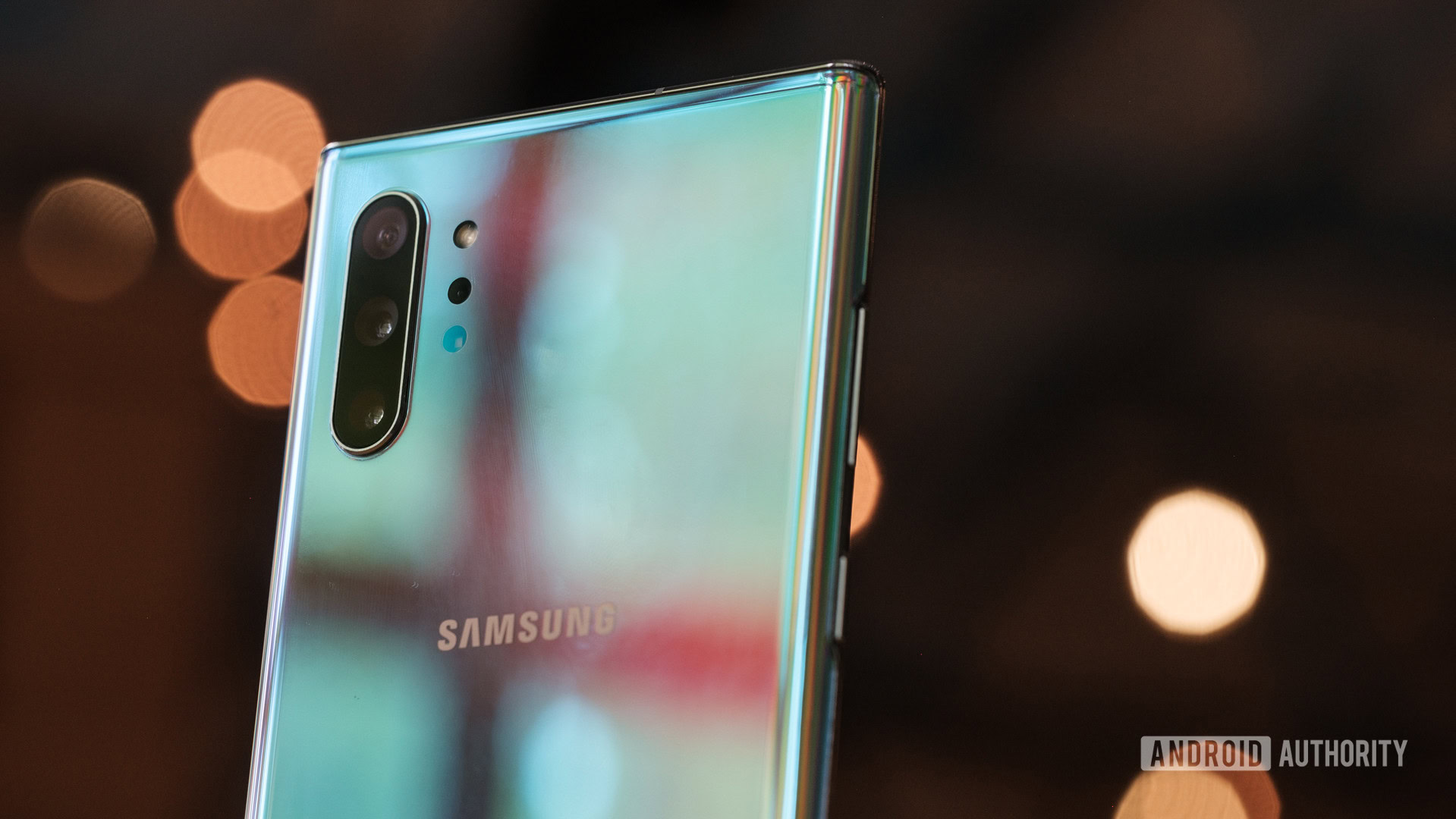
- Samsung Galaxy Note 10 Plus: 12GB RAM, 256GB Storage — $1099
- Samsung Galaxy Note 10 Plus: 12GB RAM, 512GB Storage — $1199
Value is always going to be a sticky spot for Samsung’s flagship devices. The Note 10 Plus’ $1,100 base price is one of the highest on any smartphone right now, but it’s clear Samsung is trying to keep its devices premium. The strangest thing about this pricing is this device comes a full six months after the S10 series, which have been significantly discounted since launch.
On Prime Day this year, Amazon was offering the Galaxy S10 Plus for $699. That’s $400 cheaper than the starting price for Note 10 Plus. The Note 10 Plus does have faster UFS 3.0 storage with a higher base capacity, a bigger, brighter display, the S Pen, and more RAM, but it’s missing the headphone jack the S10 Plus offers.
The top-end OnePlus 7 Pro can be had for $749 for nearly the same base specs as the Note 10 Plus, and the 7 Pro also comes with the smoother 90Hz display, though you’ll be missing on expandable storage.
This, then, leaves the S Pen and the design as the biggest differentiators between Note 10 Plus and other flagship devices. Personally, the stylus is not a vital asset for me. It can be useful for doodling on screenshots, but otherwise, I’m not convinced you need it. For digital artists, it’s a totally different story. I can absolutely see how the S Pen would be an invaluable asset for people who make art daily, but for me, it remains slotted in the phone 99% of the time.
The S Pen and the design are the biggest differentiators between Note 10 Plus and other flagship devices.
If Samsung really wanted to separate the Galaxy S line and Galaxy Note line, using the newly released Snapdragon 855 Plus would have been a great move. The company has traditionally marketed the Note series as the power user device, and while more RAM and faster storage are undoubtedly perks, the 855 Plus would have been an easy way to market the device to gaming enthusiasts. For any company that releases two devices a year, selling the newest Qualcomm chipset at the beginning of the year and the Plus model in the second half of the year is a straightforward path to making the upgrade worth it. Take note, Samsung.
New competition: Samsung Galaxy S20 Plus vs Note 10 Plus: Is newer really better?
With that said, the Note 10 series wasn’t made for power enthusiasts this year. Like I said earlier, this series was made for people who want the best design and great specs, not the power users who want something that would blow other phones out of the water on paper. Samsung is looking to rope in a much wider demographic with this device, and whether or not you agree with that move, the Note 10 Plus is still a wonderful phone.
If you’re looking for a smaller phone at a smaller cost, the entire Galaxy S10 series are great alternatives. They all come with headphone jacks, too. It would be easy to find these devices at a reduced cost as well. Though the S10 Plus is still listed at $999 on Samsung.com, deals can be found pretty much anywhere you look.
- Buy now: Samsung Galaxy S10e from Amazon
- Buy now: Samsung Galaxy S10 from Amazon
- Buy now: Samsung Galaxy S10 Plus from Amazon
If you can’t even come to close to the Note’s price, the Redmi K20 Pro / Xiaomi Mi 9T will satisfy pretty much any person looking for tons of power on a budget. They come with powerful specs, and at just $400, they’re hard to beat.
If you want a wonderful ecosystem experience and a fantastic camera, you can’t go wrong with the Google Pixel 3a or 3a XL. The 3a starts at $400, and most would consider the Pixel 3a’s camera one of the best on the market.
If you love the S Pen but want something cheaper, Samsung has recently released the Samsung Galaxy Note 10 Lite. This device has the Exynos 9810 processor which won’t get quite as good battery life as the Snapdragon 855-powered Samsung Galaxy Note 10 or Note 10 Plus. That said, it’s still quite capable, with 6-8GB of RAM and 128GB of storage with microSD card expansion.
Read more on known Galaxy Note 10 Plus issues: Samsung Galaxy Note 10 and Note 10 Plus problems, and how to fix them
Samsung Galaxy Note 10 Plus review: The verdict
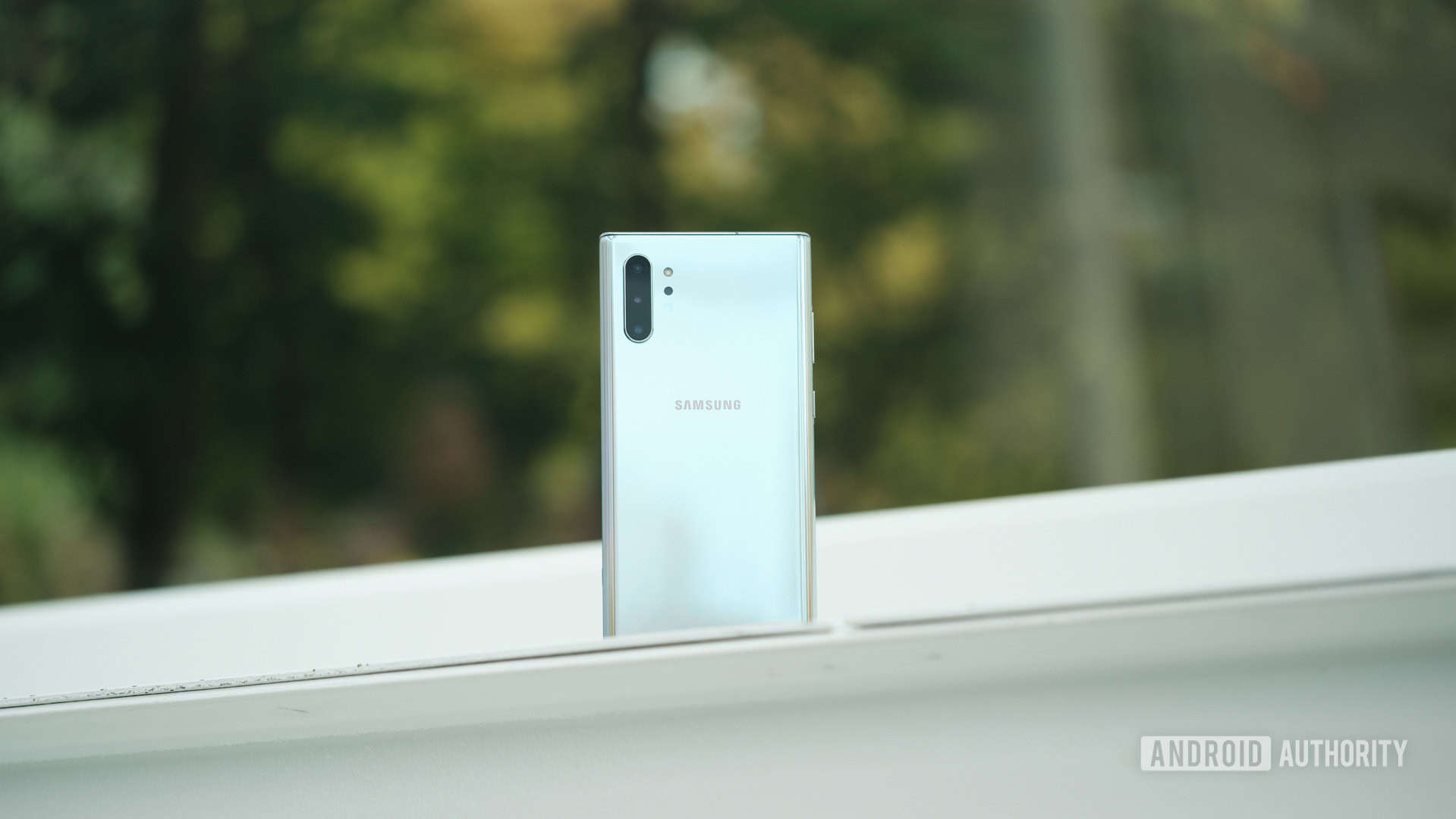
The Samsung Galaxy Note 10 Plus is a wonderful phone, but its priorities have clearly changed. Samsung is no longer trying to attract the “do anything and everything” crowd, but rather the “do what do you well and make it look good in the process” crowd. Nearly every update on the Note 10 Plus was driven by the need to attract a broader audience, which meant reducing the power user association with the device. The standard Note 10 takes this concept even further with a smaller 1080p display, no microSD card expansion, and a fairly small 3,500mAh battery.
Again, this isn’t to say the Note 10 Plus is a bad device. Personally, it’s my favorite Note made so far. But priorities have clearly changed for the company, and if you’re the hardcore power user who wants all the best specs Android has to offer, you may want to take a look at options like the ASUS ROG Phone 2.
And this concludes our Samsung Galaxy Note 10 Plus review. Will you buy this phone? Let us know in the comments!
Samsung Galaxy Note 10 Plus in the news
- Samsung Galaxy Note 20: Everything we know so far!
- Android 10 comes to Galaxy Note 10 devices in Australia, Hong Kong, more
- Best Samsung Galaxy Note 10 screen protectors
- Download the Galaxy Note 10 Plus Star Wars Edition wallpapers right here
- The Galaxy Note 10 Plus Star Wars Edition is seriously out of this galaxy
- Did you know: The Samsung Galaxy Note was mocked and predicted to flop at launch